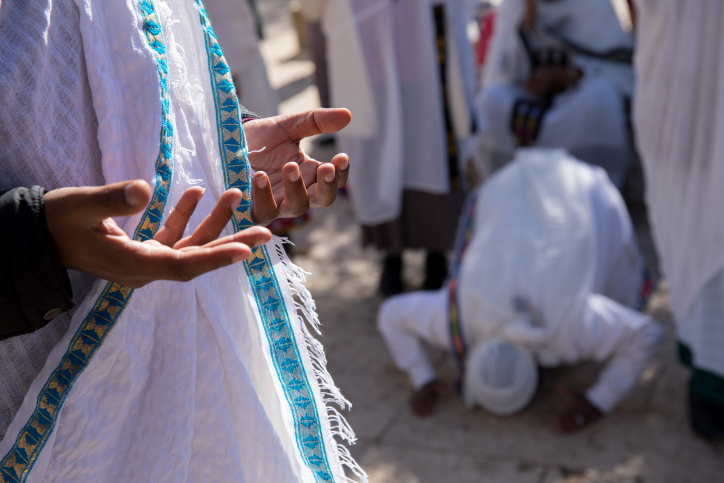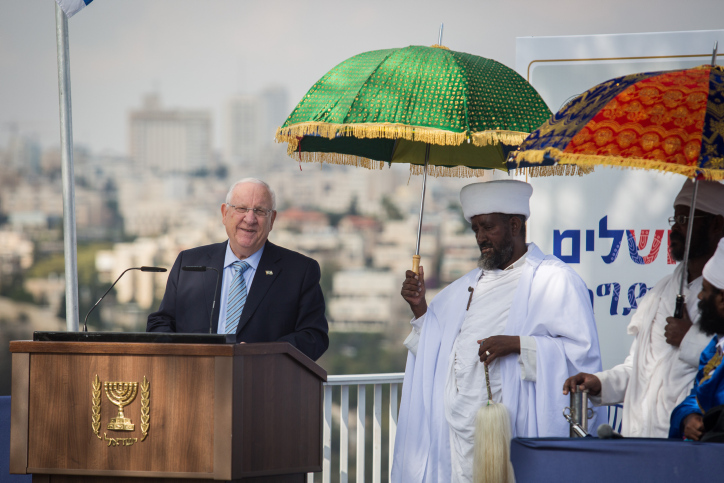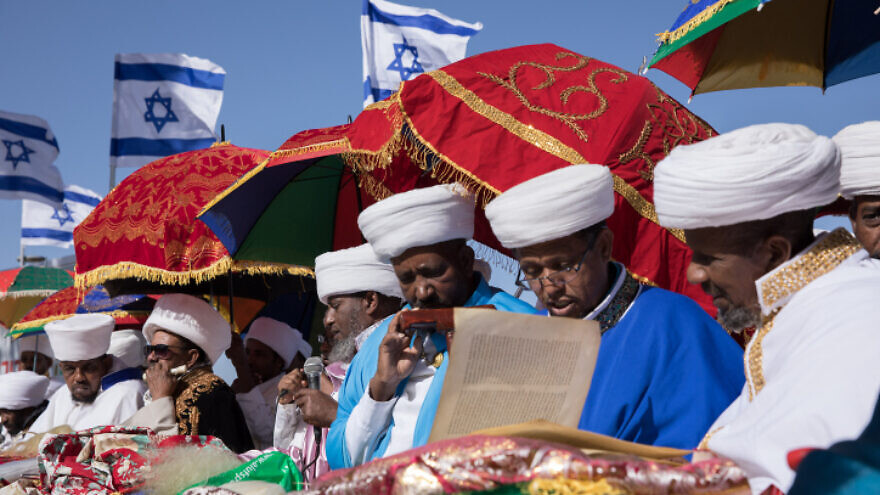The 29th of Cheshvan is not a particularly noteworthy day for most Jews. Cheshvan is the only Hebrew month that has no holidays or fast days. But for Jews from Ethiopia, this date has long been observed as one of the most important in the calendar.
Known as Sigd—“prostration” in Ge’ez, the Ethiopian liturgical language—it’s a day of rededication to God and the Torah, a celebration of the connection of the community to Jerusalem, and a commitment to Jewish unity.
In other words, it’s the ultimate Zionist festival.
In 2008, the Knesset recognized Sigd as a national holiday, raising awareness of both the festival and of Jews of Ethiopian origin.
Celebrated today in Jerusalem both at the Western Wall and on the Haas-Sherover Promenade that overlooks the Old City, the event is a multi-generational gathering that attracts thousands from all over the country.
“We missed Jerusalem for thousands of years.”
Early in the morning, a delegation of kessim (Ethiopian Jewish religious leaders) makes their way to the Western Wall to give thanks. The slender figures cut an elegant path through the Kotel plaza. Swathed in simple white robes, tallitot draped over their narrow shoulders, the kessim are accompanied by an entourage that includes escorts who hold colorful umbrellas over their heads.
The Ethiopian women arrive separately, clothed in distinctive white dresses adorned with hand-embroidered trim in the Ethiopian national colors of green, yellow and orange. Shoulders cloaked in white shawls, heads covered with colorful head scarves, the women advance shyly toward the Kotel to take part in the prayer service.

Less than a mile away, on the Haas-Sherover Promenade, the crowds gather for the official Sigd all-day celebration. With surrounding streets closed off to accommodate dozens of buses that bring thousands from throughout the country to the gathering, there’s an upbeat atmosphere, despite the seriousness of the religious holiday.
From the promenade, there’s a clear view of the Temple Mount, and thousands of Ethiopians of all ages come together to commemorate their unique holiday. Mingling with the colorful costumes and umbrellas of the elders are the khaki, green and white uniforms of dozens of young Ethiopian men and women serving in the Israel Defense Forces.
Younger teens—largely ignoring the hours of religious chanting of the elders—are socializing and decked out in a variety of trendy clothing on this festive day. Representatives of all the major youth movements in their signature white or blue shirts are a prominent presence and consist of many teens of Ethiopian origin. Ancient Geez chants make themselves heard over the gaggle of street Hebrew as the day progresses.
Prior to their mass aliyah, generations of Ethiopian Jews yearned for Zion and expressed their longing in the annual Sigd festival. Jews would walk for days to arrive at a mountaintop, where thousands would join in prayer and listen to Torah readings. Following afternoon prayers and the blowing of the shofar, the community would descend from the mountain to partake of a festive meal.
The holiday has its origins in the time of the prophets Ezra and Nehemiah, following the return of the Jews from Babylonian exile and the rebuilding of the Second Temple. Tradition holds that the entire Jewish community assembled in Jerusalem then for a day of fasting and confession. “Ezra blessed the Lord, God, and the entire people responded ‘Amen, Amen,’ and they … bowed down and prostrated themselves” (Nehemiah 8:6).
Sigd as observed today in Israel is led by the kessim, and many of the elders prostrate themselves in response to the readings.
‘We never left Sudan, in some sense’
On the promenade, one kes—a diminutive man with a silver beard wearing a white knitted kipah—tells visitors about his extraordinary life story and explains where Sigd fits into the life of Ethiopian Jews.
He graphically describes how men and women would separately observe the ritual of ascending the mountain for the great Sigd gathering. He points out that the tradition of Sigd was handed down by oral tradition.
“Many Jews believe that we didn’t know from the oral tradition,” he says. The kes carefully explains the Ethiopian Jewish engagement and wedding ceremonies, and asserts that their practice conforms to the Mishnaic description in Tractate Kiddushin (part of the Oral Law) of what constitutes proper Jewish betrothal.
He finishes his story by noting that Sigd was essentially a way of remembering Jerusalem and strengthening Jews in a difficult Diaspora situation. But the holiday is just as relevant today.
“We missed Jerusalem for thousands of years,” he notes. “Today, in Jerusalem, we celebrate … but just as we say ‘Next year in Jerusalem’ at the Passover seder, so, too, at Sigd, we pray for a rebuilt Jerusalem.”
Just behind him, two young men preside over a table full of information about the rebuilding of the Temple and a large picture of a dozen kessim standing in front of a reconstructed Temple.
Over the past few days, various members of the Ethiopian Jewish community have used the Sigd holiday to speak out in the media about their experiences and concerns.
Danny Adino Abebe, a prominent journalist who came to Israel in 1984 at age 9 with his parents as part of “Operation Moses,” explains how deeply the lengthy, dangerous trek through the Sudan affected him and his family. “Sudan is ingrained in us. We never left Sudan, in some sense,” he says.
Similar to many Holocaust survivors, it’s taken decades for the older generation, who suffered the physical and emotional trials of leaving a hostile Third World country to arrive in modern Israel, to start to open up about their painful experiences.
“Many Jews believe that we didn’t know from the oral tradition.”
While noting that Ethiopian Jews of his generation have become successful in many fields, “nevertheless we have a problematic, complicated past,” says Abebe. “We’ll only ever overcome it if we make this part of Israeli culture.”
Sharon Shalom immigrated to Israel alone at the age of 9. Today, he is an ordained rabbi and serves as a captain in the IDF reserves. He is also a senior lecturer at Ono Academic College, teaches at Bar-Ilan University in Ramat Gan, and serves as rabbi of the “Kdoshei Israel” community in Kiryat Gat.
In a short Hebrew video titled “Ten Facts You Didn’t Know About the Sigd Festival,” Shalom points out that in addition to the religious significance of the day, one of the main themes of Sigd activities is reconciliation and the breaking down of barriers between people.

It’s a message echoed by Ofer Berkovitch, former deputy mayor of Jerusalem and head of the Hitorerut (“Awakening”) Party, who is also a member of the Jerusalem city planning and construction committee.
“The Beta Yisrael community is part of the rich diversity that makes up Israel,” Berkovitch tells JNS. “As a representative of the Jerusalem municipality, I’m here to express the wish to see all Jews join together. Jews of Ethiopian origin yearned for centuries for Jerusalem. They have a unique and special culture, and we need to make efforts to ensure their integration while maintaining their identity.”


























